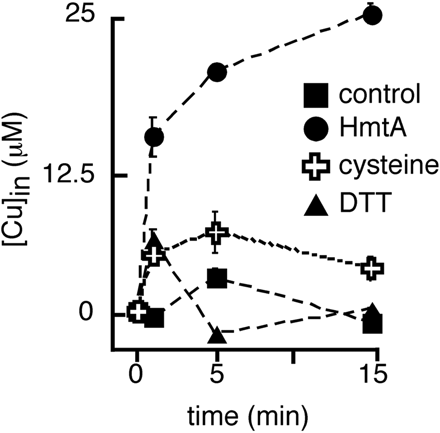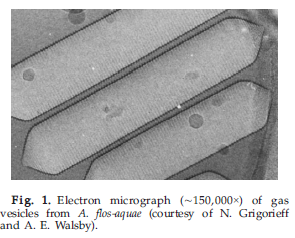Team:Groningen/Project/Transport
From 2009.igem.org
Svenjurgens (Talk | contribs) (→Arsenic) |
Svenjurgens (Talk | contribs) (→HmtA) |
||
| Line 15: | Line 15: | ||
==HmtA== | ==HmtA== | ||
| + | [[Image:Hmta.gif|300px|thumb|right|Time-dependent copper uptake. Cells transformed with empty plasmid (squares) or HmtA-encoding plasmid (all other traces) were cultured in the absence of metals, washed with metal-free buffer, and allowed to recover in the presence of glucose. Transport was initiated by the addition of 250 nM CuCl2, and samples were withdrawn at the indicated times. Where indicated, 0.5 mM DTT or 0.25 mM cysteine was included in the reaction mixture. Total internal metal concentrations were measured by inductively coupled plasma mass spectroscopy. Error bars represent standard deviations of three repeats.]] | ||
| + | HmtA, heavy metal transporter A from Pseudomonas aeruginosa Q9I147 is a P-type ATPase importer. It mediates the uptake of Copper (Cu) and Zinc (Zn) and is functionally expressed in E.coli. | ||
| - | + | >gi|81857196|sp|Q9I147|Q9I147_PSEAE Probable cation-transporting P-type ATPase | |
| + | {| border="1" | ||
| + | !Enzyme | ||
| + | !Number of Sites | ||
| + | |- | ||
| + | |EcoRI | ||
| + | |0 | ||
| + | |- | ||
| + | |XbaI | ||
| + | |0 | ||
| + | |- | ||
| + | |NotI | ||
| + | |0 | ||
| + | |- | ||
| + | |SpeI | ||
| + | |0 | ||
| + | |- | ||
| + | |PstI | ||
| + | |2 | ||
| + | |} | ||
| - | |||
| - | + | ===Missing information/To do=== | |
| + | *Expression assesment | ||
| + | **Stability | ||
| + | **Level | ||
| + | *Functional assesment | ||
| + | **Uptake speed | ||
| + | **Affinity | ||
| + | **Electrolyte potential generating force | ||
| + | *Eliminate BioBrick restriction sites | ||
| + | ===Literature=== | ||
| + | Lewinson O., Lee A.T., Rees D.C. 2009. A P-type ATPase importer that discriminates between essential and toxic transition metals. PNAS. vol. 106, no. 12, p. 4677-4682. | ||
==Mer operon== | ==Mer operon== | ||
Revision as of 13:26, 7 June 2009
Introduction
About 150 species of prokaryotes (well studied examples are cyanobacteria and halophilic archaea) in aquatic habitats have been shown to contain gas vesicles. These gas vesicles provide cells with bouyancy, there function is either to positioning the bacterium (in water) in order to get the right amount of oxygen or the right amount of light. Gas vesicles are made exclusively of proteins and contain gas. When gas vesicles are present in a cell, the overall density of that cell is lowered and the cell becomes bouyant.
We want to utilize this bouyancy for an application like for example separation of specific molecules or specific cells.
Gas vesicles are hollow proteinous organelles made of gvpA and gvpC (in cyanobacteria) and are permeable to gases and fills by diffusion. It is impermeable to water because of its hydrophobic inside. GvpA is a small 70AA long protein which forms a linear crystalline array of ribs to form the cylindrical shell and conical ends. GvpC is usually on the outside of the gas vesicle to make it stronger and stabilizes the structure (see Figure 1).
In B. megaterium a gas vesicle gene-cluster was found, which contained 14 gvp genes (gas vescicle polycitonic genes) which were functionally expressed in E. coli by Ning Li and Maura Cannon (Li and Cannon, 1995). The best bouyant fenotype was found when gvpA, gvpP, gvpQ and ORF-1 were excluded (see figure 2). It was suggested that gvpB on the gvp-cluster of B. megaterium is an homolog of gvpA.

- Figure 2: gvp cluster B. megaterium. Taken from Li and Cannon, 1995
HmtA

HmtA, heavy metal transporter A from Pseudomonas aeruginosa Q9I147 is a P-type ATPase importer. It mediates the uptake of Copper (Cu) and Zinc (Zn) and is functionally expressed in E.coli.
>gi|81857196|sp|Q9I147|Q9I147_PSEAE Probable cation-transporting P-type ATPase
| Enzyme | Number of Sites |
|---|---|
| EcoRI | 0 |
| XbaI | 0 |
| NotI | 0 |
| SpeI | 0 |
| PstI | 2 |
Missing information/To do
- Expression assesment
- Stability
- Level
- Functional assesment
- Uptake speed
- Affinity
- Electrolyte potential generating force
- Eliminate BioBrick restriction sites
Literature
Lewinson O., Lee A.T., Rees D.C. 2009. A P-type ATPase importer that discriminates between essential and toxic transition metals. PNAS. vol. 106, no. 12, p. 4677-4682.
Mer operon
Missing information
Literature
Lewinson O., Lee A.T., Rees D.C. 2009. A P-type ATPase importer that discriminates between essential and toxic transition metals. PNAS. vol. 106, no. 12, p. 4677-4682.
 "
"

